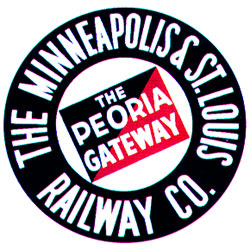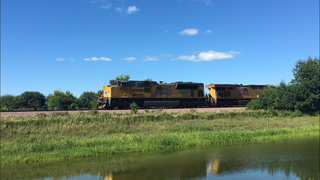Related Research Articles

Hudson is a city in St. Croix County, Wisconsin, United States. As of the 2010 United States census, its population was 12,719. It is part of the Minneapolis–St. Paul Metropolitan Statistical Area (MSA). The village of North Hudson is located directly to the north of Hudson.

The Chicago, Burlington and Quincy Railroad was a railroad that operated in the Midwestern United States. Commonly referred to as the Burlington Route, the Burlington, or as the Q, it operated extensive trackage in the states of Colorado, Illinois, Iowa, Missouri, Nebraska, Wisconsin, Wyoming, and also in Texas through subsidiaries Colorado and Southern Railway, Fort Worth and Denver Railway, and Burlington-Rock Island Railroad. Its primary connections included Chicago, Minneapolis–Saint Paul, St. Louis, Kansas City, and Denver. Because of this extensive trackage in the midwest and mountain states, the railroad used the advertising slogans "Everywhere West", "Way of the Zephyrs", and "The Way West".

The Hiawathas were a fleet of named passenger trains operated by the Chicago, Milwaukee, St. Paul and Pacific Railroad between Chicago and various destinations in the Midwest and Western United States. The most notable of these trains was the original Twin Cities Hiawatha, which served the Twin Cities in Minnesota. The train was named for the epic poem The Song of Hiawatha by Henry Wadsworth Longfellow.

The Chicago and North Western was a Class I railroad in the Midwestern United States. It was also known as the "North Western". The railroad operated more than 5,000 miles (8,000 km) of track at the turn of the 20th century, and over 12,000 miles (19,000 km) of track in seven states before retrenchment in the late 1970s. Until 1972, when the employees purchased the company, it was named the Chicago and North Western Railway.

The Chicago, St. Paul, Minneapolis and Omaha Railway or Omaha Road was a railroad in the U.S. states of Nebraska, Iowa, Minnesota, Wisconsin and South Dakota. It was incorporated in 1880 as a consolidation of the Chicago, St. Paul and Minneapolis Railway and the North Wisconsin Railway. The Chicago and North Western Railway (C&NW) gained control in 1882. The C&NW leased the Omaha Road in 1957 and merged the company into itself in 1972. Portions of the C. St. P. M. and O. are part of the Union Pacific Railroad network. This includes main lines from Wyeville, Wisconsin, to St. Paul, Minnesota, and St. Paul to Sioux City, Iowa.

The Minneapolis and St. Louis Railway (M&StL) was an American Class I railroad that built and operated lines radiating south and west from Minneapolis, Minnesota for 90 years from 1870 to 1960. The railway never reached St. Louis but its North Star Limited passenger train ran to that city via the Wabash Railroad.
Edwin Wheeler Winter was president of Northern Pacific Railway in 1896 then president of Brooklyn Rapid Transit Company, Brooklyn Heights Railroad and allied companies.

The Arrow was a passenger train operated by the Chicago, Milwaukee, St. Paul and Pacific Railroad between Chicago, Illinois and Omaha, Nebraska. It operated from 1926 until 1967. The Arrow provided overnight service between the two cities and included through cars for other destinations in Iowa.
The Minnesota Transfer Railway was a short line railroad in the United States. It was incorporated on March 22, 1883.

The Twin Cities Hiawatha, often just Hiawatha, was a named passenger train operated by the Chicago, Milwaukee, St. Paul and Pacific Railroad, and traveled from Chicago to the Twin Cities. The original train takes its name from the epic poem The Song of Hiawatha by Henry Wadsworth Longfellow. There are a number of Hiawatha-themed names within the city of Minneapolis, the terminus of the original train. The first Hiawatha ran in 1935; in 1939 the Milwaukee Road introduced a second daily trip between Chicago and Minneapolis. The two trains were known as the Morning Hiawatha and Afternoon Hiawatha, or sometimes the AM Twin Cities Hiawatha and PM Twin Cities Hiawatha. The Milwaukee Road discontinued the Afternoon Hiawatha in 1970 while the Morning Hiawatha continued running until the formation of Amtrak in 1971.
The West Wisconsin Railway was a small railroad in Wisconsin, connecting the Chicago and North Western Railway at Elroy, Wisconsin to Hudson, Wisconsin. It became part of the Chicago, St. Paul, Minneapolis and Omaha Railway. This Omaha Road merged into the Chicago and North Western Railway. Today some of its route is still active as Union Pacific's Altoona Subdivision between Saint Paul and Altoona, Wisconsin.
Org is an unincorporated community in Nobles County, Minnesota, United States.
The Mankato Subdivision or Mankato Sub is a railway line operated by the Union Pacific Railroad. It runs generally southwest, starting at Chestnut Street in Saint Paul, Minnesota, where it crosses the Mississippi River, then runs south along the Mississippi and then the Minnesota River to Mankato, where it turns away from the river and continues west to St. James. From there Union Pacific's rails continue southwest toward Sioux City, Iowa, as the railroad's Worthington Subdivision.

Charles Elliott Perkins was an American businessman and president of the Chicago, Burlington and Quincy Railroad. He was so well respected that historian Richard Overton wrote, "From the time that Charles Elliott Perkins became vice president of the Chicago, Burlington and Quincy [1876] ... until he resigned as president in 1901, he was the Burlington."
The Winona and St. Peter Railroad was a railroad in the Midwestern United States. It was founded in 1861 in Winona, Minnesota. The first 11 miles (18 km) from Winona to Stockton, Minnesota, were completed by the end of 1862, making the it the second operational railroad in Minnesota, after the St. Paul and Pacific Line from Saint Paul to St. Anthony Falls.

Alvaren Allen was a businessman and Democratic politician who served as the second mayor of St. Anthony, Minnesota.

The Ellis and Eastern Company is a railroad owned and operated by Sweetman Construction Company.
The Worthington Subdivision or Worthington Sub is a railway line operated by Union Pacific Railroad. It runs generally southwest-northeast and begins at a siding in St. James Township, Minnesota, where the Mankato Subdivision ends, and it continues to Sioux City, Iowa. The line has yard facilities in Worthington and Sioux City, as well as a small yard north of Worthington in Hersey and Lorain townships called Elk Creek. The line passes through many small towns and villages with grain elevators along its route, and it is the origin of numerous grain unit trains.
The North Wisconsin Railway was incorporated by the State of Wisconsin in 1871 to build a railroad from Lake St. Croix to Lake Superior. This route was built from Hudson, Wisconsin to Superior, Wisconsin. The route went through Spooner, Wisconsin, where the route from Chippewa Falls joined at what was then called Chicago Junction.

The Altoona Subdivision or Altoona Sub is a 90.7-mile (146.0 km) railway line owned and operated by the Union Pacific Railroad in the states of Minnesota and Wisconsin. The line originates in Saint Paul, Minnesota, crosses the St. Croix River on the Hudson Bridge into Hudson, Wisconsin, and eventually terminates in Altoona, Wisconsin where it connects to the Wyeville Subdivision. This subdivision is formerly a Chicago and North Western Railway (C&NW) mainline, on which the Twin Cities 400 operated in the mid 1900s.
References
- ↑ Minnesota. Office of Railroad Commissioner (1879). Annual Report. pp. 1–.
- ↑ Frank Pierce Donovan (May 2000). Iowa Railroads: The Essays of Frank P. Donovan, Jr. University of Iowa Press. pp. 138–. ISBN 978-0-87745-723-7.
- ↑ [https://supreme.justia.com/cases/federal/us/159/349/ Sioux City and St. Paul R. Co. v. United States, 159 U.S. 349 (1895). JUSTIA. Accessed 12 August 2022.
- ↑ Library of Congress: History of the St. Paul & Sioux City Railroad, 1864-1881. Bishop, J. W. (Judson Wade), 1831-1917. Publ. Minnesota Historical Society. St. Paul, Minn., 1905. Accessed 12 August 2022.
- ↑ Robert Joseph Casey (1948). Pioneer railroad the story of the Chicago and North Western System. Robert Joseph Casey. pp. 151–. GGKEY:WK1RLEKNSCN.
- ↑ Grant, Roger - Minnesota's Good Railroad - The Omaha Road. Minnesota Historical Society. www.mnhs.org/mnhistory
- ↑ Minnesota (1881). General Laws of the State of Minnesota. Pioneer Company. pp. 916–.